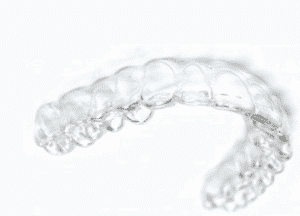Generally when the course of braces is finished some form of retention is necessary to help maintain an optimal result. If for example you did nothing and just left the teeth it would be very unlikely that they will revert back to their original position straight away; however, over the course of time it is likely that things will not stay exactly how they were when the braces came off. This is because occlusion is dynamic and a balance of forces and muscle teeth bones will tend to change over time.
So what can be done to help maintain a perfect result?There are different forms of retainers, the two main types would either be a fixed retainer or a removable retainer.
- A Fixed retainer – is bonded or glued to the back of the teeth, like braces but on the inside. This type of retainer is often quite nice as it is always in place and we do not have to worry about it day to day. However, one downside is that overtime the resin buttons that are used to glue the retainer in place may need to be adjusted and repaired; as they may become damage or worn down with day to day eating and chewing. In terms of cleaning these types of retainers may be more likely to allow plaque accumulation, and may need a bit more cleaning over time. There are different types of fixed retainers. The two most common would be a traditional fixed which is a wire bonded straight across the back of the the teeth. These ones are generally less expensive, but harder to clean. Or a W-retainer or classically called a hygienic retainer this type of retainer looks like an up and down bend wire, the main purpose is to allow for a dip in-between the teeth, this makes it possible to floss and keep the teeth as clean as possible. This type of retainer can be a bit more expensive, as it is custom fabricated to your teeth at the dental laboratory.
- A Removable retainer – very similar to Clear Correct or Invisalign braces is a thin clear plastic that is made from a mold of your teeth and fits nicely in place. This type of retainer is commonly used at night. Some people like this style of retainer as nothing is glued to the teeth and the teeth can easily be cleaned. Removable retainers will generally wear down over the weeks and months some faster than others but will likely need to be replaced over time. The biggest down side of removable retainers is that they are only going to work if they are in, which is an inherit weakness as we are all human and it is likely that people will forget from time to time, which may cause a bit of drifting or movement. These types of retainers are often less expensive than a fixed retainer, but depending on the life span may need to be be replaced over time which could occur before a fixed retainer might need any maintenance.
It is possible to go from fixed to removable or vice verse there is nothing to say that you are stuck with one or the other. Some people will prefer fixed others will prefer removable. Further, some people may have a fixed on the bottom teeth and removable on the top or vice versa. It could be possible to try one form of retention and if you like it can stay or if there are any issue it is possible to change to the other form.
Can you get a retainer without braces?
It is possible to get a retainer without having braces done, or if you have had braces in the past and you are noticing some movement but would like to stop it in its tracks it could be possible to do this with a retainer(either a fixed or removable). If you wish to correct the teeth before the retainer this can also be done but would need braces to idealize the teeth first.
If you would like to discuss or would like further information you can contact Skygate Dental.


